

Dry stone walls that separate lots or uphold flat terrain on slopes are a wonderful chance to display a variety of flowers while not wasting any space.
→ Read also:
• Landscaping a slope: great ideas
• Rock garden set-ups
It’s better to think it through before even building the wall, so that adding plants later on is safe and easy. On dry stone walls (stones without any mortar), plants often colonize spaces on their own. When cement is used to fasten the stones, you need to provide pockets of soil for planting later on. If you don’t, instead of a plant-covered wall, your only option will be to plant along the base of the wall.
Admittedly, this is a big step 😋. But we’ll guide you through it in detail!
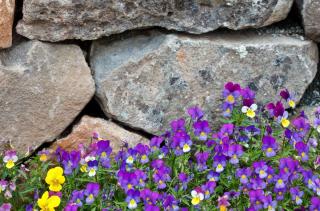
A trapezoid shape makes them more stable, but it also means the wall tapers and gets thinner near the top of the structure. This angle is called the batter. It must range from 3 to 10%, which is about a hand’s width at the palm at most, for every 3 feet (1 meter).
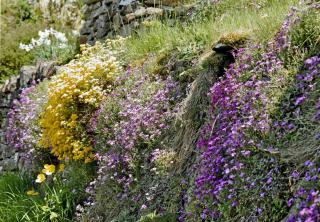
Stones can be set in horizontal layers, like a staircase, or slanted for a smoother appearance.
You can shape or trim the stones (“ashlar”) or use them as is.
If the wall is holding back soil, compute its width from the height of the soil behind it: the thickness of the wall at its base should be at least equal to one-third that height. For example, 1 foot wide if there’s 3 feet of soil on the backside (35 cm thick for 1 meter of soil held back).
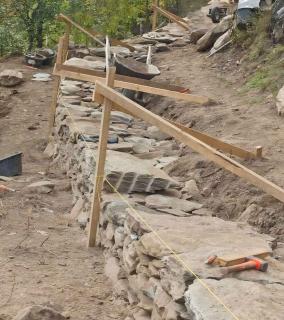 Build 2 wooden “templates”, or batter-frames, they will help you stay constant, keeping the batter and the horizontal layers even during the entire building project.
Build 2 wooden “templates”, or batter-frames, they will help you stay constant, keeping the batter and the horizontal layers even during the entire building project.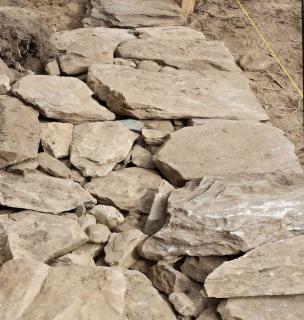 Give the stones a very light slope to the inside of the wall, going down towards the side that retains soil. Use pebbles to prop them up. Add dirt between stones whenever the distance between them reaches half an inch (1 to 2 cm). Behind the front-facing stones, at various intervals, prepare hollow spaces which you only fill up with dirt and soil, not stones.
Give the stones a very light slope to the inside of the wall, going down towards the side that retains soil. Use pebbles to prop them up. Add dirt between stones whenever the distance between them reaches half an inch (1 to 2 cm). Behind the front-facing stones, at various intervals, prepare hollow spaces which you only fill up with dirt and soil, not stones.Smart tip:
It’s best to sow and plant your flowers at the same time you’re building your wall. Remember to space plants by 2 to 3 feet (60-80 cm) so that the stones themselves are still visible after the clumps have grown. If any closer, you’ll have a wall that’s completely covered in vegetation.
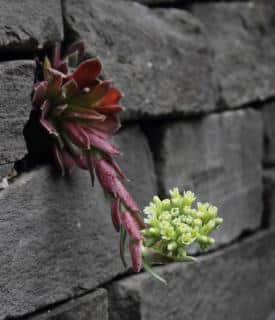 Keep the nicest, flattest stones for last. Use them for the last layer, forming the top into neat, straight tiling. On the side retaining soil, extend these capstones by at least a foot (30 to 40 cm), covering the packed soil there.
Keep the nicest, flattest stones for last. Use them for the last layer, forming the top into neat, straight tiling. On the side retaining soil, extend these capstones by at least a foot (30 to 40 cm), covering the packed soil there.These stones at the top are called “capstones” because they’re at the top of the wall. Ideally, they’re wider than the wall itself, so that they can really extend onto the soil-filled side of the retaining wall.
You have to focus on plants that are used to surviving in very little soil.
Alpine plants and “rock plants” are surely those that are best suited to growing in such an environment. Roots must weave their way between rocks.
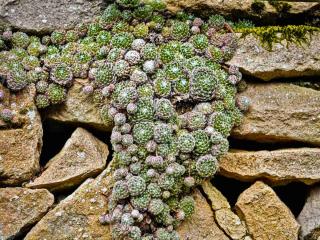
You can also add succulents like common houseleek (Sempervivum tectorum) which will have fun colonizing every rock (shown in the picture above/right), as will the well-named wallflowers.
Factor exposure in when establishing the list of plants for your dry wall.
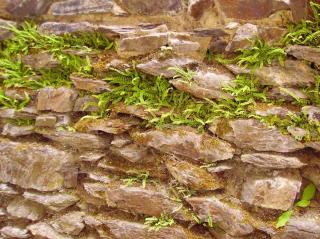 A wall facing North is a boon for all types of fern, especially Polypodium vulgare, Phyllitis scolopendrium and Asplenium trichomanes, as well as ivy and periwinkle.
A wall facing North is a boon for all types of fern, especially Polypodium vulgare, Phyllitis scolopendrium and Asplenium trichomanes, as well as ivy and periwinkle.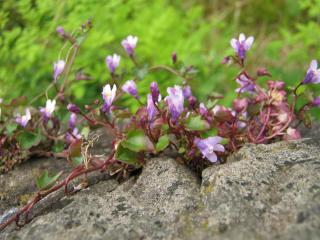
Smart tip:
Try to make the network of soil pockets deep and voluminous, and, if possible, let them open into the side of the wall holding the dirt back. Roots can thus dig deep into the mound for water.
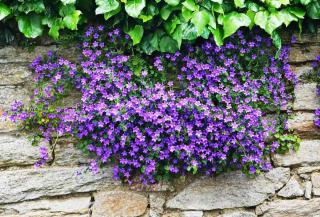 Walls facing either East or West only get sun during half of the day. Plants that usually like South-facing exposure usually cope fine with part shade, but you can add plants that like moisture a bit more such as Campanula portenschlagiana, sandwort (Arenaria montana), Erinus alpinus, saxifrage…
Walls facing either East or West only get sun during half of the day. Plants that usually like South-facing exposure usually cope fine with part shade, but you can add plants that like moisture a bit more such as Campanula portenschlagiana, sandwort (Arenaria montana), Erinus alpinus, saxifrage…